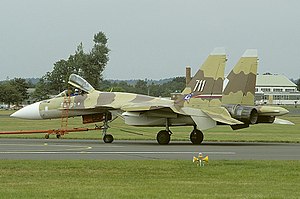| Su-37 | |
|---|---|
 | |
| General information | |
| Type | Air superiority fighter technology demonstrator |
| National origin | Russia |
| Designer | Sukhoi Design Bureau |
| Built by | Komsomolsk-on-Amur Aircraft Production Association |
| Status | Out of service and production, prototype |
| Number built | 1[1] |
| History | |
| Introduction date | 25 October 1997 |
| First flight | 2 April 1996 |
| Developed into | Sukhoi Su-30MKI (India) Sukhoi Su-30MKM (Malaysia) Sukhoi Su-30SM (Russia) Sukhoi Su-35 (Russia and China) |
The Sukhoi Su-37 (Russian: Сухой Су-37; NATO reporting name: Flanker-F; popularly nicknamed "Terminator"[2]) was a single-seat twin-engine aircraft designed by the Sukhoi Design Bureau which served as a technology demonstrator. It met the need to enhance pilot control of the Su-27M (later renamed Su-35), a further development of the Su-27. The sole example built was originally the eleventh Su-27M (T10M-11) built by the Komsomolsk-on-Amur Aircraft Production Association before having thrust-vectoring nozzles installed. It also had updated flight- and weapons-control systems. The aircraft made its maiden flight in April 1996. Throughout the flight-test program, the Su-37 demonstrated its supermaneuverability at air shows, performing manoeuvres such as a 360-degree somersault. The aircraft crashed in December 2002 due to structural failure. The Su-37 did not enter production, despite a report in 1998 which claimed that Sukhoi had built a second Su-37 using the twelfth Su-27M airframe,[3] T10M-11 remained the sole prototype. Sukhoi had instead applied the aircraft's systems to the design bureau's other fighter designs.
- ^ Russia's Road to Corruption: How the Clinton Administration Exported Government Instead of Free Enterprise and Failed the Russian People, U. S. House of Representatives (2000), P. 204
- ^ Jackson, Paul, ed. (2009). Jane's All the World's Aircraft 2009–2010. Jane's. p. 515. ISBN 978-0710628800.
This was popularly termed 'Su-37 Terminator' ...
- ^ Gethin 1998, p. 32.